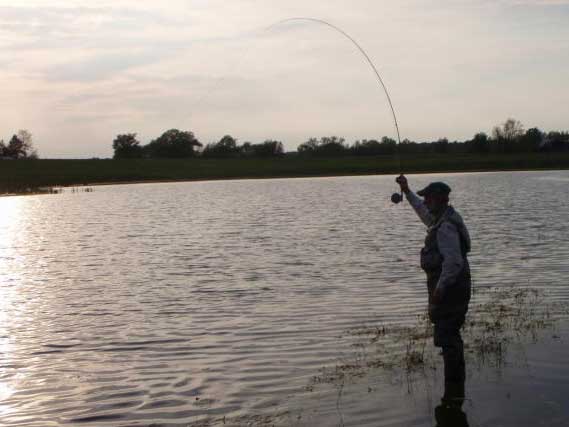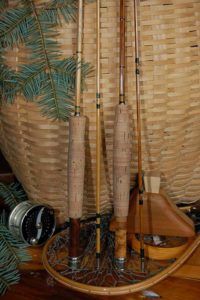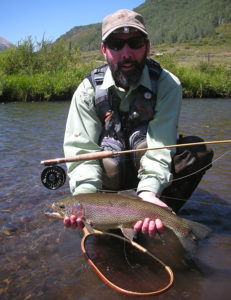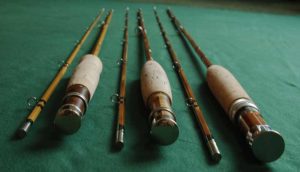
A Split Bamboo Fly Rod, Which One’s Right for You?
A lot of serious fly casters have dreamt, “Some day I’m gonna have a rod just like that.” That rod of course is made of split bamboo. So when the day arrives for Mr. or Ms. Angler to acquire a split bamboo fly rod, how does he or she make a wise choice? My advice is to consider two things before making that long awaited purchase: first, who made the rod and what rod action or taper design will fit a person’s style of fishing.
 When shopping for a split bamboo rod the newcomer basically has three options in terms of who made the rod. The first choice is one of the classics made by an “Old Master.” Second, is a vintage production rod manufactured by skilled workers and third a modern split cane fly rod crafted by a contemporary professional or semi-professional rodmaker. The list of classic rodmakers, the “Old Masters,” includes names like Leonard, Payne, Edwards, Young, Dickerson, Powell, Gillum, and Garrison. Rods carrying these signatures are expensive but well worth the investment both as fishing tools and for resale. Expect prices for an old classic to start at around a thousand dollars with prices skyrocketing for rare or collector rods! Less costly, but in many cases equally satisfying and functional, are older production rods from companies such as Heddon, Montague, Granger, Wright/McGill, Phillipson, South Bend, Orvis, Horrocks/Ibbotson, and others. Many of the production rods were longer and heavier than classics but when used in the right conditions, lakes and large rivers, proved quite acceptable. In classic and production rods, length and line weight will determine price; usually the shorter the rod the higher the price. Reliable information on older split bamboo fly rods can be found in Classic Rods and Rod Makers, Martin Keane, 1976, Trout Tackle Two, Ernest Schwiebert, 1984 and Bamboo Rod Restoration Handbook, Michael Sinclair, 1994. Also worth taking a look at are Splitting Cane by Ed Engle and The Best of The Planing Form, Volume One, Defining The Magic of Split Bamboo, Ron Barch, 1997.
When shopping for a split bamboo rod the newcomer basically has three options in terms of who made the rod. The first choice is one of the classics made by an “Old Master.” Second, is a vintage production rod manufactured by skilled workers and third a modern split cane fly rod crafted by a contemporary professional or semi-professional rodmaker. The list of classic rodmakers, the “Old Masters,” includes names like Leonard, Payne, Edwards, Young, Dickerson, Powell, Gillum, and Garrison. Rods carrying these signatures are expensive but well worth the investment both as fishing tools and for resale. Expect prices for an old classic to start at around a thousand dollars with prices skyrocketing for rare or collector rods! Less costly, but in many cases equally satisfying and functional, are older production rods from companies such as Heddon, Montague, Granger, Wright/McGill, Phillipson, South Bend, Orvis, Horrocks/Ibbotson, and others. Many of the production rods were longer and heavier than classics but when used in the right conditions, lakes and large rivers, proved quite acceptable. In classic and production rods, length and line weight will determine price; usually the shorter the rod the higher the price. Reliable information on older split bamboo fly rods can be found in Classic Rods and Rod Makers, Martin Keane, 1976, Trout Tackle Two, Ernest Schwiebert, 1984 and Bamboo Rod Restoration Handbook, Michael Sinclair, 1994. Also worth taking a look at are Splitting Cane by Ed Engle and The Best of The Planing Form, Volume One, Defining The Magic of Split Bamboo, Ron Barch, 1997.
The best news for today’s angler interested in acquiring a split bamboo fly rod is the increasing number of highly skilled contemporary bamboo rodmakers. Currently throughout North America, Europe, and Japan, modern rod makers are producing split bamboo rods that equal or surpass the work of earlier artisans. Modern methods and materials enable contemporary craftsmen to offer an excellent product with the selection getting larger each year. If you choose to purchase a rod from a contemporary craftsman request references, test cast his rods, and get to know the rodmaker’s thoughts on construction methods and rod design. Expect to pay from $700 (2 pc/single tip) to $1,500 but prices can exceed $2,400 for select split bamboo rods. Increased costs are due to cosmetic refinements and specialized techniques such as fluting, hollowing, quadrate and nodeless construction.
If a rodmaker can’t or won’t provide references and an opportunity to cast his rods, I’d look elsewhere.
During the 1990’s a renaissance of split bamboo rodmaking occurred resulting in dozens of talented craftsmen setting up shop. Even though the number of qualified rodmakers is on the rise, like any other purchase “buyer beware” remains solid advice. Slick varnish and bright reel seats can mask a cane rod’s reason for existence, which is to cast a line in a pleasing and efficient manner. If a rodmaker can’t or won’t provide references and an opportunity to cast his rods, I’d look elsewhere. I use this rule of thumb when testing a cane fly rod: A good cane rod, whether a plain Jane or exquisite magic wand, is fun to cast.
 Once the angler has decided on a price range, good pre-owned rods can be priced as reasonably as $300 to $400, and to a rodmaker, the next important decision is rod action and length. Rod length is easier to deal with than taper design so let’s begin there. Split bamboo rods excel in lengths from 6-8 feet. For small stream work choose a 7 foot, 4 weight. For larger rivers and lakes an 8ft 6wt is hard to beat. The 7ft 6-inch 5wt. is a good compromise and the epitome of an all around classic cane rod. My own personal favorites are rods designed by Young, Payne and Garrison. The designs for these rods are readily available to the modern craftsman and can be reproduced by experienced rod maker.
Once the angler has decided on a price range, good pre-owned rods can be priced as reasonably as $300 to $400, and to a rodmaker, the next important decision is rod action and length. Rod length is easier to deal with than taper design so let’s begin there. Split bamboo rods excel in lengths from 6-8 feet. For small stream work choose a 7 foot, 4 weight. For larger rivers and lakes an 8ft 6wt is hard to beat. The 7ft 6-inch 5wt. is a good compromise and the epitome of an all around classic cane rod. My own personal favorites are rods designed by Young, Payne and Garrison. The designs for these rods are readily available to the modern craftsman and can be reproduced by experienced rod maker.
The casting action of a rod is determined by the way the blank tapers from tip to butt. Taper styles can be divided into two basic designs, progressive and compound. A rod whose taper measurements increase uniformly from tip to butt is considered a linear or progressive action. Measurements across two opposite flats would increase or decrease at a constant rate, for example: .062 .070 .078 (an increase of .008 of an inch at each station). On the other hand, a taper in which there is less change in measurements across the flats in the midsection of the rod is termed a compound taper. Compound tapers can be divided into parabolic and semi-parabolic configurations. For the most part modern designs are derived from the compound taper family.
 Progressive or compound, which rod action is for you? If your style of casting is methodical and deliberate, then a progressive taper would be a good choice. Classic rods designed by Powell and Winston fall into this category. Conversely, the angler who prefers fast action, quick tips, and versatility should opt for a compound tapered fly rod. Payne, Young and Garrison are examples of compound tapered rod designs. Another way to look at rod tapers and actions is to consider the activities the rod will be used for. Down and across streamer fishing for salmon and steelhead, bass bugging, or a leisurely wade prospecting a favorite stream are good reasons to select a progressive taper. If the angler spends most of his time pursuing trout using an upstream, traditional dry fly approach, then I’d recommend one of the compound tapers. Rods designed by Everett Garrison fall somewhere in the middle and would be an excellent choice for a person’s first cane rod. Garrison’s designs are available in lengths 6’9” to heavy duty salmon models. Remember: a methodical and deliberate casting style, choose a progressively tapered rod and for fast action and versatility a compound taper is recommended.
Progressive or compound, which rod action is for you? If your style of casting is methodical and deliberate, then a progressive taper would be a good choice. Classic rods designed by Powell and Winston fall into this category. Conversely, the angler who prefers fast action, quick tips, and versatility should opt for a compound tapered fly rod. Payne, Young and Garrison are examples of compound tapered rod designs. Another way to look at rod tapers and actions is to consider the activities the rod will be used for. Down and across streamer fishing for salmon and steelhead, bass bugging, or a leisurely wade prospecting a favorite stream are good reasons to select a progressive taper. If the angler spends most of his time pursuing trout using an upstream, traditional dry fly approach, then I’d recommend one of the compound tapers. Rods designed by Everett Garrison fall somewhere in the middle and would be an excellent choice for a person’s first cane rod. Garrison’s designs are available in lengths 6’9” to heavy duty salmon models. Remember: a methodical and deliberate casting style, choose a progressively tapered rod and for fast action and versatility a compound taper is recommended.
A competent rodmaker should be able to intelligently discuss design subtleties and make a rod from either family. Just making a pretty cane rod does not earn one the title of rodmaker. When selecting a split bamboo fly rod, begin with taper design and action. Remember: function before form.




Brian Hirst
Thanks for this explanation and description of rod tapers. Helps me understand why I had trouble with feeling like I could get a comfortable cast from a Young, 7-6 5 weight but loved to cast an old, noodley, FE Thomas 8′ 4 weight..
Mike Thomas
This is an extremely helpful explanation of the difference between types of tapers for a person new to cane rods, like me. It has opened my eyes to which classic tapers to look for.
Thank you
Martin Angers
Ron Barch, made me a fabulous and Beautiful Garrison 204 E ,with 3 tip sections as I requested many years ago.. Thanks so much for doing such a Beautiful Job…It casts like a dream and is a very special and important part of of my Sporting Lifestyle Collectibles ,I call My personal treasures that I am proud to show off and use with complete confidence…Well done Sir!